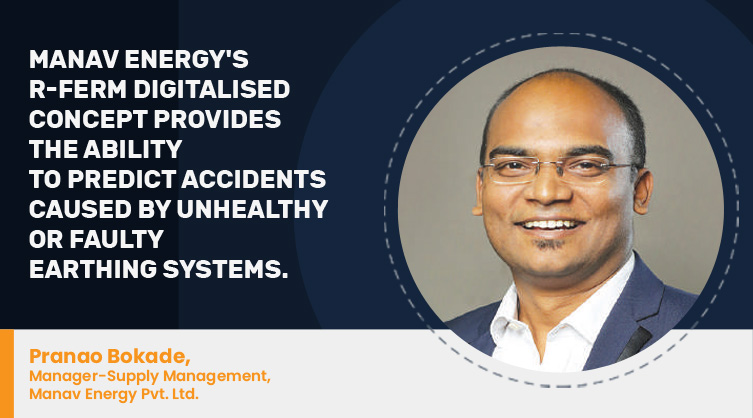We are creating an automated system for electrical maintenance
By EPR Magazine Editorial September 27, 2022 2:13 pm IST
By EPR Magazine Editorial September 27, 2022 2:13 pm IST

Emphasising their patented projects, Pranao Bokade, Manager-Supply Management, Manav Energy Pvt. Ltd. highlights that the R-FERM digitalised concept reduces time and effort and provides an automated system for maintenance.
Increasing efficiency in securing contracts and managing electrical projects
We need to consider a standardised approach. When you implement a standardised approach to your project management process, there are plenty of benefits. As we all know, electrical projects can change fast, and managing scope creep on projects means being able to react to growth or a change in requirements using a set format.
A proper project management procedure allows you to deal with impacted schedules, short deadlines, and any other issues that crop up. In short, having a naileddown approach means you can facilitate real-time updates while still ensuring that long-term deadlines and budgets are met.
Secondly, we need project management software. Good software will be accessible instantly on mobile or tablet and help ensure everyone in the field or the office is on the same page. Direct access to this information helps your team give reliable answers and build trust with the client. Some of the benefits of having project management software include having a central point of communication to speak with the entire team. It easily tracks costs in real time and against budgets. It also allows us to have template documents and enables easy project creation. It also provides you with storage and file access. 
Improve your communication flow across the project
Good communication is an essential element across every phase of an electrical project. Creating lines of communication early on within the project is vital. You can create a channel for the project to give everyone a central place for daily communication, although arguably, this may be better for internal teams.
Manage the different stages and suppliers of your electrical project.
Ensure a reliable supply chain: The clients want to know that a reliable supply chain is working on their project and doing its best to provide high-quality services on time. Clearly stating project milestones and ensuring they can help meet them will keep your project running smoothly.
Mitigate procurement issues: One measure to reduce project hold-ups is ensuring that procurement is taken care of as early as possible. A solution is to sit down at the beginning of the project with your estimator and go through the specifications and original estimate for the project. Highlight any items that might be unusual, require a special order, or are known to have extended delivery times.
Factors to consider for electrical installations for underground and overhead safety
Before doing any construction site work, you need to consider three key things:
Risk assessments
Before work on a construction site begins, the person in charge, by law, must carry out a risk assessment. This aims to identify all potential electrical hazards and ensure that suitable control measures are in place to prevent them from causing harm to workers. If you are an employee about to start work on a construction site, then make
sure you familiarise yourself with the risk assessment results to understand which hazards you need to look out for.
Your site engineer should have obtained up-to-date maps from the client that detail where any potentially hazardous wires, cables, or electrical equipment are located within (or near) the construction site. Again, ensure you have familiarised yourself with these maps (if any) before beginning work.
Safe systems of work
If your role on the construction site requires working directly with (or near) live electricity, then you must be fully trained and competent to carry out the work safely. Your employer will have set out a safe system of work (SSoW) that specifies the competence, skills, and knowledge required to do this task. Before beginning work, ensure that you’ve read the SSoW document carefully and have taken on board all the information and training provided by your employer. A training course is to be arranged to ensure that both employers and employees understand the main risks and the necessary controls for the safe use of electricity at work.
Safety-specific specialised tools and equipment
Continuity, insulation resistance testers, Earth fault loop impedance testers, and residual current devices are key to monitoring safety. All test equipment must be chosen to comply with the relevant standards. Test instruments must carry a calibration certificate; recorded results may be void.System planning and management for electrical contracting and project management
Effective implementation of a new system has four distinct phases. Failure to follow this process will typically result in performance far below expectations. It includes;
Group meeting/flowcharting: This phase is complete when everyone agrees to a basic flowchart of the process, a timeline, responsibilities for different parts of the endeavour, and a simple bullet-point description of the process.
Process documentation should come in several formats depending on the process, including a written process that can go in a binder, an online video, and possibly a slide presentation for training in larger groups.
Training: Training will be more about the hands-on resolution of problems and documenting details about how to perform a task better.
Verification: It’s essential to address some quality control methods when designing the process. This often requires you to build simple queries into the system database.
Patented IIoT products by Manav Energy
Remote fault-time earth resistance monitoring system (R-Ferm)
Manav Energy has indigenously developed R-FERM, which can automate earthing system measurement and maintenance practice. By monitoring individual earth pits, R-FERM provides the ability to prevent accidents caused by unhealthy or faulty earthing systems. On the occurrence of a fault, the concerned person is notified. The behaviour of the earth pit during fault conditions can be observed. If any discrepancy is found, corrective actions can be taken immediately. Manual measurement of an earthing system consumes great effort, time, and money. The R-FERM digitalised concept reduces time and effort and provides an automated system for maintenance.
Lightning management and alert system (LMAS)
A one-of-a-kind system that can manage lightning hazards by intelligently mitigating a lightning strike and providing a full-scale alert that ensures every person is in the safe zone. The LMS (Lightning Management System) predicts the occurrence of storms and manages the high energy dissipation.
The LAS (Lightning Alert System) alerts the authorities of the prevailing unsafe condition during lightning. The LAS is integrated with the LMS electronically to form an LMAS that detects, predicts, measures, and enunciates each environment’s storm and lightning conditions, thus providing safety and reliability to lives, livestock, and assets.
Key features
Our installation experts are responsible for planning, executing, monitoring, controlling, and closing projects. We at Manav Energy provide training to our engineers for addressing different parameters, along with refresher and technology advancement training.
During this training, the engineers will be updated on the latest products and services, with site-specific training provided as per the site requirements.
We use cookies to personalize your experience. By continuing to visit this website you agree to our Terms & Conditions, Privacy Policy and Cookie Policy.